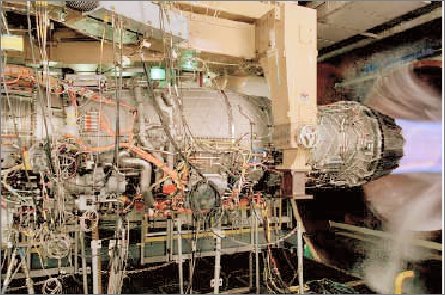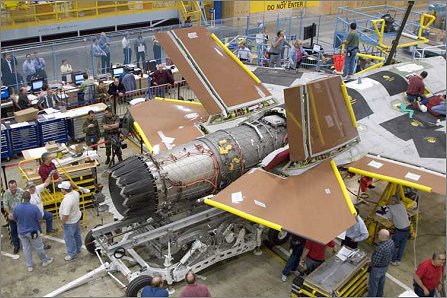US/UK team could get a year to convince Pentagon and lawmakers JSF alternate powerplant is worthwhile
US Congress could provide a year’s reprieve for the Joint Strike Fighter (JSF) alternative engine programme, but the threat of cancellation will not be lifted from the General Electric/Rolls-Royce F136 unless supporters can convince the Pentagon and sceptical lawmakers that competition will reduce cost and improve reliability.
|
| P&W is ground testing production F135s |
While fighter engine competitions worked well in the past, opponents of developing the F136 as an alternative to Pratt & Whitney’s F135 engine argue advances in technology over the past 30 years have removed the justification of hedging against an engine problem that could ground the entire JSF fleet.
“All of our analysis shows that we never recover the costs of this programme,” deputy defence secretary Gordon England told a special Congressional hearing in mid-March. He was defending the Department of Defense’s decision to cancel the F136 just six months after awarding the GE/R-R team a $2.4 billion development contract.
Pressed by powerful senators supporting the F136 to explain the DoD’s “perplexing turnaround”, England was adamant: “If we are required to fund another engine...it will end up delaying and putting the basic programme at risk.” There is no “free money”, he said. “The money will come right out of the Joint Strike Fighter programme.”
Putting the cost to qualify and to support an alternative engine at $4-6 billion, Louis Chenevert, president and chief operating officer of P&W parent United Technologies, argued the costs “will outweigh any savings” and told Congress: “If the government opts to split the purchase, neither supplier will be able to deliver maximum savings from economies of scale.”
GE Aviation president and chief executive Scott Donnelly warned Congress that a sole-source engine would guarantee P&W $60-80 billion in revenue over the JSF’s life – and could put GE out of the fighter engine business. “There’s only one aircraft, and if you’re not that aircraft then you’re not in the fighter engine business,” he said.
|
| The F135 is installed in the first F-35A, which will fly this year |
R-R North America president and chief executive James Guyette called cancelling the F136 “a shortsighted budget decision...so we can eliminate $1.8 billion in near-term costs and forego something in the neighbourhood of $16 billion in financial benefits”. He told Congress: “We have a choice: monopoly or competition.”
Senate armed services committee chairman John Warner has proposed providing $400 million in funding this year to keep the F136 alive, but a stay of execution may not be enough unless GE/R-R can make a compelling case for competition. A year from now the F135 will be flying and gaining experience, while the F136, running three years behind, will still be in ground test.
GE began ground tests of the third build of the F136 in conventional take-off and landing (CTOL) configuration at its Peebles, Ohio test site in February. After several runs, the engine was converted to short take-off and vertical landing (STOVL) mode and began tests in around mid-March. GE says around 100h are planned in this configuration through to mid-April.
The current test phase has three main targets including performance assessment, validation of the engine control system architecture and durability at high operating temperatures. Control system validation is a pre-requisite for full-up propulsion system tests planned in 2007, while the durability tests are aimed at “demonstrating performance with what we’ve got, so we’ll know what we need to do to grow the engine for future thrust requirements,” says GE.
Results from the current tests will feed into a preliminary design review scheduled to be held with the JPO in November. Under the $2.4 billion system development and demonstration (SDD) contract awarded last year, GE/R-R plans to build seven engines for ground tests beginning in mid-2008 and seven for flight tests starting in 2010. Low-rate production engines will become available in 2012, just as the JSF becomes operational.
P&W, meanwhile, delivered the second flight test F135 on 22 March, for use as a spare in the F-35A flight-test programme, which is scheduled to begin in the third quarter. The initial flight-test engine, delivered in December, is already installed in the first F-35 at Lockheed Martin’s Fort Worth site in Texas. A second spare flight test engine is to be shipped in July.
The company has amassed almost 4,800 ground test hours so far during the F135 SDD phase and plans to reach 6,400h by year-end. Nine test engines are currently in use – five CTOL and four STOVL – with three more ground-test engines still to join the development effort.
“We are intensely into our CTOL qualification activities and our plan is to complete flight qualification work by the end of April,” says P&W F135 vice-president Bill Gostic.
A CTOL ground-test engine is now being disassembled and inspected following completion of accelerated mission tests, and a further pair of test engines is to undergo the same treatment following completion of simulated high-altitude testing at the end of April. P&W and the F135 have a lead that threatens to become unassailable.
GRAHAM WARWICK / WASHINGTON & GUY NORRIS / LOS ANGELES
Source: Flight International

























